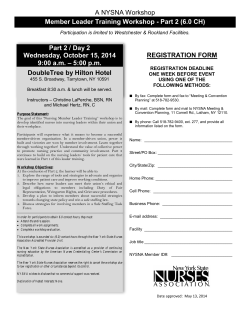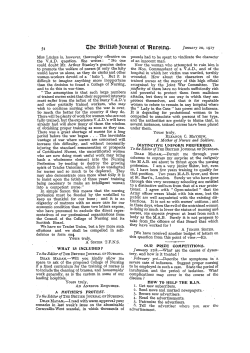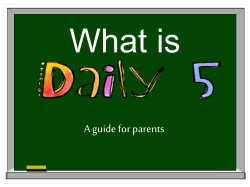
Professionalism: Creating a Nurse MARYLAND ASSOCIATION OF ASSOCIATE
Professionalism: Creating a Nurse Barbara Cherry, DNSc, MBA, RN, NEA-BC MARYLAND ASSOCIATION OF ASSOCIATE DEGREE NURSING DIRECTORS ANNUAL CONFERENCE OCTOBER 14, 2011 Maryland Association for Associate Degree Nursing Directors THE BENEFITS OF ASSOCIATE DEGREE NURSING – THE FOUR A’S ACCOUNTABLE: ACCESSIBLE: Provide access to nursing education for students from broad socio-economic strata Flexible scheduling options such as evening, weekend programs. Part-time educational opportunities to meet student needs AFFORDABLE: 60% of all Maryland’s registered nurses graduate from AD programs Maryland AD grads consistently perform above the national average on NCLEX 90% of graduates are employed in Maryland Mainly publicly funded: cost is approximately $7,000-$9,000. Commands a starting salary range from $40,000 to $50,000 Graduates who continue their education may earn while they learn ARTICULABLE: Articulation models exist to facilitate educational mobility LPN to AND, ADN to BSN, ADN to MSN, EMT-P to RN Program Objectives Analyze professionalism as an explicit set of behaviors and values that require ongoing learning and development. Examine characteristics of today’s college student and their impact on the development of professional behaviors. Outline academic infrastructure requirements to support the development of professional behavior among students. Implement strategies to promote professional behavior in the classroom and clinical setting. Treat professional development as an ongoing process of learning and development. Today’s Agenda Today’s college student What is “professionalism”? The evidence for teaching professionalism Model for “creating a nurse” Program standards – Leadership support Evidence-based teaching strategies Innovative programs and curricula Student responsibilities National League for Nursing: Excellence in Nursing Education Program Standards – Leadership Support Innovative Programs & Curricula EvidenceBased Teaching Methods Questions to Consider Professionalism: What is it and how can it be meaningful to students? Professional development: How do students come to value and improve their professional behavior? Teaching strategies: What strategies can be used in the classroom or clinical setting to promote professional behavior? You are doing a great job! “Nursing education is very strong in the pedagogies….that are effective in helping students develop a deep sense of professional identify, commitment to the values of the profession, and to act with ethical comportment” (Benner et al, 2010, p. 11) Benner, P., Sutphen, M., Leonard, V. & Day, L. Educating Nurses: A Call for Radical Transformation. San Francisco: Jossey-Bass. Getting Started: What is the Problem? What are the common unprofessional behaviors you observe in your students? TODAY’S COLLEGE STUDENTS HTTP://WWW.YOUTUBE.COM/WATCH?V =DGCJ46VYR9O Generational Differences Millennials: Generation X: Baby Boomers: Traditionalists: Born 1982 – 2002 Born 1965 – 1982 Born 1946 - 1964 Born 1900 – 1946 Millennials Grew up in a time of great prosperity Most protected generation in history Highly scheduled and sheltered in childhood Often indulged and protected from the concept of “losing” Generally optimistic and strive for a work-life balance Millennials Maintain constant social contact via text, social media, etc.. Regularly use digital devices to interact with the world Find information on-line rather than using a book Multitasking is a way of life Tend to be collaboratively, team-oriented and prefer group work Millennials Today’s Students (Group Work!) What are the positives and strengths about today’s students? How can you capitalize on those strengths to improve their educational journey and promote professionalism? Program Standards – Leadership Support Innovative Programs & Curricula EvidenceBased Teaching Methods PROGRAM STANDARDS and LEADERSHIP SUPPORT Foundational Support to Promote Professionalism Commitment to promote professionalism “from the top” Consistent expectations across all courses and clinical experiences Consistent consequences across all courses and clinical experiences supported by policies Inclusion of professionalism in the formal curriculum Commitment to faculty development http://www.nursing.iupui.edu/students/professionalism .shtml Policy Implementation Increasing the chances for successful policy implementation VALUES: Views about what should be BELIEFS: Assumptions about what is INTERESTS: Responses to incentives and rewards Primary Goals for Students To become a skilled and serious professional who knows how to dress and act the part To engage in the desire to become a respected member of their chosen profession Keys to Student Development Faculty must be vested in the student’s success though role-modeling Create a sense of pride and excitement in the student’s chosen profession Faculty Expectations Role model professional behavior Be aware and responsible for your own behavior One study found observed faculty (Clark, 2007): Belittling students Changing policies and procedures Demonstrating bias and discrimination Prevalence is estimated to be 50% of faculty Clark, C. & Springer, P. (2007). Thoughts on incivility: Student and faculty perceptions of uncivil behavior in nursing education. Nursing Education Perspectives, 26(2), 93-97. EVIDENCE-BASED TEACHING METHODS Evidence-Based Teaching Theoretical framework Situational learning theory Cognitive learning combined with real-world activities or experiential learning Explicitly teach the cognitive base of professionalism Knowledge and ability to articulate the concept is essential Provide a list of traits and characteristics expected of the professional Promoting Professionalism Cognitive Learning + Experiential Learning = Development of Professionalism Professionalism: Exactly what is it? Basic Professional Behaviors Honesty and integrity Reliability and dependability Accountability Respect and courtesy towards others Professional appearance Neat, well-dressed conveys a higher level of knowledge Appearance cannot guarantee success but it can ensure failure Professionalism: Exactly what is it? Basic Professional Behaviors (continued) Discretion and confidentiality Professional communication Compassion Maintain appropriate boundaries Believe in and support colleagues Commitment to personal health Development of Professionalism as a Continuum Advanced Professional Behaviors Cultural humility Avoid introducing irrelevant and destructive bias into clinical practice and professional relationships Nonjudgmental behavior Commitment Clinical to excellence excellence Personal standard of excellence – be the best that you can be Development of Professionalism as a Continuum Advanced Professional Behaviors Willingness to examine one’s own behavior and take responsibility for actions and reactions Commitment to lifelong learning Patient advocacy Involvement in professional organizations Pursuit of advanced education Development of Professionalism as a Continuum “Partnership with the public” to provide safe patient care “Excellence in nursing is not just about kindness. It’s about providing thoughtful, complex intellectually-demanding care with compassion” Diana J. Mason Fashioning the Right Impression Imprint, February/March 2009, page 29 How do professional behaviors look in practice? Guide students to visualize how professional behaviors are actually practiced in classroom & clinical setting: Discusses patients in a respectful manner and only when appropriate Takes responsibility for being on-time and prepared for class Seeks help and guidance from instructors, preceptors, and/or other health care professionals Maintains composure during difficult interactions Shows initiative for own learning Focuses on healthy behaviors – eating right, exercise and adequate sleep What does unprofessional behavior look like? Sloppy, unkempt appearance with violations of the dress code Failure to be prepared for class or clinical assignments Requires continual reminders about responsibilities to fellow students or to patient care assignments Lack of conscientiousness – failure to fulfill responsibilities – doing only the minimum Lack of effort towards developing and improving clinical skills Failure to accept responsibility for errors and to learn from mistakes Poor interactions and/or a lack of respect for fellow students, instructors, patients and families Chronic fatigue and sleep deprivation Arrogant and demeaning behavior Skills for Professionalism Specific skills needed by the novice professional Clinical skills Interpersonal skills Professional communication Self-control to manage difficult encounters Time management skills Planning Organizing Delegating Priority setting Personal health and energy management Consequences of Unprofessional Behaviors Inability to get hired Inability to keep a job Failure to be promoted Lack of respect from clients and colleagues Potential legal consequences INNOVATIVE PROGRAMS & CURRICULA What would you do to promote professionalism among your students? Teaching Activities Exposure to expert, highly respected role models Role models across several levels from student leaders, staff, faculty and practicing professionals Story Telling Address negative role modeling Provide opportunities to discuss professional issues in a safe environment Tell about a time when a coworker or fellow student showed true professionalism Teaching Activities Encourage self-reflection through journaling Keep a log of experiences and reflect on the professional behaviors experienced or reinforced Learning from lapses in professionalism Internet Exercises – Social Media Involvement in professional activities outside the classroom or clinical setting Journal clubs National Student Nurses Association Seminars with local, state and national nurse leaders Free from the National Student Nurses Association Diana J. Mason: Fashioning the Right Impression. February/March 2009 Donna Cardillo: Projecting Your Professionalism, February/March 2009 Kathleen Pagana: Your Professional Presence: Advice on Dress and Appearance. February/March 2009 Teaching Activities Make expectations and consequences completely clear and CONSISTENT Ground rules for conduct, dress and behavior in clinical and classroom settings Learning contracts for individual students Clear communication about how the student is or is not meeting professional expectations Teaching Activities Use case scenarios Example: During lunch, a student makes demeaning remarks about a patient he has seen in the clinic today; Discussion questions What do you think of this behavior? Is the student acting professionally? Is the student breaching confidentiality by describing details about the patient to other students who are not directly involved in the patient’s care? How would you respond to the student’s remarks? Student experiences Scenarios from popular TV shows Professional Code of Conduct Sample statements from the Code of Conduct for Student Nurses (from the National Student Nurses Association) Advocate for the rights of all clients. Maintain client confidentiality. Take appropriate action to ensure the safety of clients, self, and others. Provide care for the client in a timely, compassionate and professional manner. Communicate client care in a truthful, timely and accurate manner. Actively promote the highest level of moral and ethical principles and accept responsibility for our actions. Promote excellence in nursing by encouraging lifelong learning and professional development. Treat others with respect and promote an environment that respects human rights, values and choice of cultural and spiritual beliefs. Strive to achieve and maintain an optimal level of personal health. What Now? Start on the Right Side Wait and hope Take action and learn Blame self Find solutions Blame others Accept ownership Denial Acknowledge situation “Somebody should do “It starts with me” something” “It starts with me” Complex Work Glouberman, S. & Zimmerman, B. (2001). Complicated and Complex Systems: What Would Successful Reform of Medicare Look Like? Available online at http://www.plexusinstitute.org/resource/collection/6528ED29-9907-4BC7-8D00-8DC907679FED/ComplicatedAndComplexSystemsZimmermanReport_Medicare_reform.pdf Simple: Following a Recipe The recipe is essential Recipes are tested to assure easy replication No particular expertise is required. But cooking expertise increases success rate Recipes produce standardized products Complicated: Sending a Rocket to the Moon Formulae are critical and necessary Formulae have a limited application Sending one rocket increases assurance that the next will be OK High levels of expertise in a variety of fields are necessary for success Rockets are similar in critical ways Complex: Raising a Child Raising one child provides experience No assurance of success with the next child Expertise can contribute but is neither necessary nor sufficient to assure success Every child is unique and must be understood as an individual The best recipes give good results every time There is a high degree of certainty of outcome Uncertainty of outcome remains Optimistic approach to problem possible Optimistic approach to problem possible Optimistic approach to problem possible
© Copyright 2025













